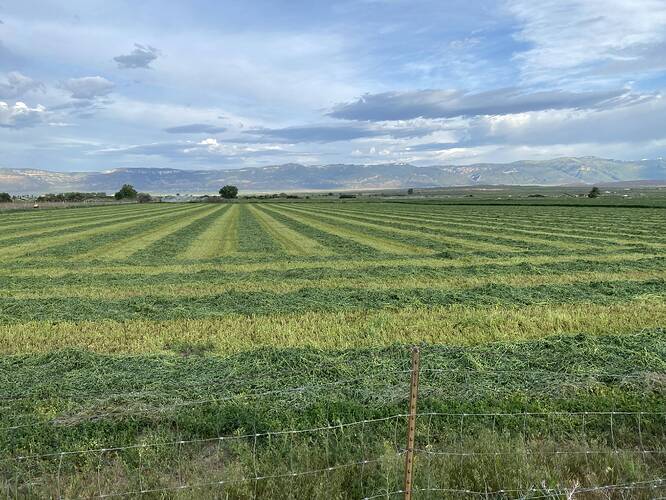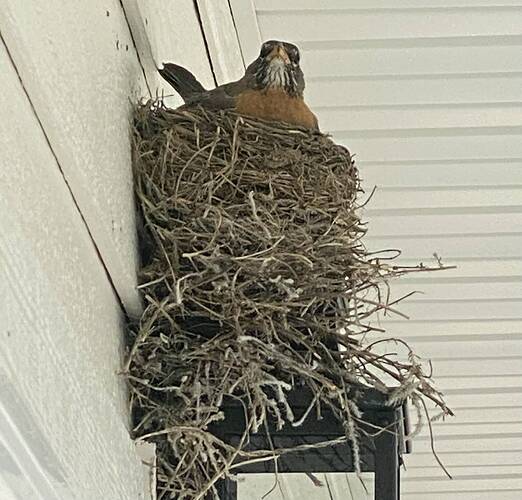Beautiful shot. What’s the mountain in the background?
It’s Horseshoe Mountain, overlooking Mount Pleasant and (mostly) Spring City.
Some of the most beautiful country anywhere, particularly this time of year.
The rule at my moms house growing up was that you couldn’t swim in the creek unless the snow was gone from horseshoe mountain.
Proud of my family history going back to the founding of Spring City.
There’s a lot of worry about flooding this year when that happens.
Looks pretty close. Some guys like to wait for flowers to pop. If you are cutting for silage it looks ready now. I think most of this goes for cubed hay for export so I’m guessing maybe in the next week or so.
This farmer likes to have the alfalfa 3-4" below his beltline. He’s about 6’ tall. It’s educational for this city boy to watch.
Beautiful shot. What’s the mountain in the background?
Here’s another shot, before the crops have started to grow.
And @Guba, as soon as it flowered, he cut it.
Flowers are the signal for a lot of guys who like bale the hay. My grandpa was one who cut at that stage. A guy I used to help with putting up silage would cut much earlier. He would put it in a silage pit and I got to drive a big tractor to push the ground up alfalfa and/ or barley up into the pit and drive over it to pack it down. The pit was basically a concrete pad with vertical concrete walls on either side. It was kind of fun to drive the tractor over the growing pile of silage.
Flowers are the signal for a lot of guys who like bale the hay. My grandpa was one who cut at that stage. A guy I used to help with putting up silage would cut much earlier. He would put it in a silage pit and I got to drive a big tractor to push the ground up alfalfa and/ or barley up into the pit and drive over it to pack it down. The pit was basically a concrete pad with vertical concrete walls on either side. It was kind of fun to drive the tractor over the growing pile of silage.
Yeah, my guy bales it all, as far as I know. Interestingly, after he cuts it he leaves it lying on the field for a few days. He says the moisture that collects in those long rows of cut alfalfa helps when it’s all baled. I forget why he says that is.
If you cut in the morning there could be dew or other moisture on the outside of the alfalfa. You let it sit and absorb the moisture so it’s dry on the outside but moist in the plants. Wet hay (on the outside) can mildew which makes it inedible for animals. Some guys back home will use dryers to help get rid of excess water from rain before baling. Modern round balers are often essentially shrink wrapped in plastic to keep the rain off until the hay is fed to animals.
My dad worked for Hesston. They made a machine that made full haystacks (looked like a giant loaf of bread), and also a machine that would move those stacks. There was less “waste” as rain would only get on the outside of the stack and not work it’s way down amongst individual bales.
My dad worked for Hesston. They made a machine that made full haystacks (looked like a giant loaf of bread), and also a machine that would move those stacks. There was less “waste” as rain would only get on the outside of the stack and not work it’s way down amongst individual bales.
My neighbor would have 2 of those hay stacks delivered for their milk cows for the winter. He got a little mad at his son and I after we burrowed a hole inside and made a little fort.
Here’s one of those Hesston hay stackers at work. Stacking Hay with a Hesston 30B - June 2019 - YouTube
I would say that Hesston made/makes some of the best hay equipment in the business. Back in the day we cut barley silage with a Hesston forage harvester. It did a great job of cutting and chopping green feed to make great silage. They also had some great hay conditioning equipment as well.
Mother robin, just outside one of our windows.
LA, that sequence of photos is a little… sobering. Not even Elton John singing Circle of Life can buffer than visual.
(Fortunately, redtails rarely go after birds.)
LA, that sequence of photos is a little… sobering. Not even Elton John singing Circle of Life can buffer than visual.
(Fortunately, redtails rarely go after birds.)
We are hopeful that predators will not be interested in this little nest. It is built so that it is practically glued to our house, and is protected by an 8–10 foot overhang. There’s no place for a fox or a cat or other predator to climb to get up to the nest, and I don’t think any soaring predator like a red tail would venture that far under the overhang, and that close to the house. I hope so, anyway. Nature is pitiless around here, I’m afraid.



